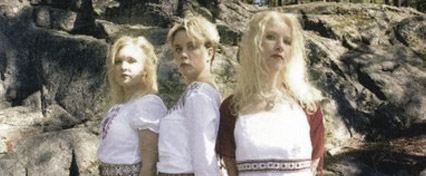
While I highly recommend all of these groups (most of whom have CDs available through Northside music here in the States), I want to focus primarily on Värttinä today. If they are known much in this country beyond Finnish-American circles, it is probably due to their collaboration with Indian musician A. R. Rahman on the music for the stage performance of The Lord of the Rings, presented in Toronto and in London (where I saw it). The group began as a celebration of the particular voices and harmonic styles of the Finno-Ugric region, particularly Karelia, home to the Kaasinen sisters, Sari and Kari, who were key in organizing the first version of the group and its first self-titled CD. The style features strong vocals (some have even called them harsh) and close harmonies that often sound somewhat disturbing to Western ears.

“Värttinä” means spindle and as you might guess by their choice of that name, from the start the group focused on the particular experience of women, much of it inspired by the folksongs and poems collected in The Kanteletar. While The Kalevala was collected and assembled by doctor and folklorist Elias Lönnrot to provide a coherent epic narrative to the mythic tales and traditional songs performed by the rune-singers in the towns and villages of Finland, The Kanteletar was a more loose catch-all of lyrics and ballads. The lyrics are sorted by those sung by all, then those sung by girls, those by boys, by women and by men. It is this gendered experience that the women of Värttinä try to capture in their songs, many of which replicate the experience of the chants and ritualized charm songs of The Kanteletar. Singing itself is a magical act, as both The Kalevala and The Kanteletar make clear—Väinämöinen is able to sing his upstart competitor, Joukahainen, up to his neck in a swamp with only the power of his voice, and a good number of the women’s songs include lullabies which act as protective charms over the children in their arms or draw unsuspecting lovers near.
Värttinä’s breakthrough album, Seleniko, contains many good examples of both traditional songs in this vein as well as the group’s invention of new lyrics for traditional tunes that follow the same style of charm magic. For example, “Lemmennosto” [darling-buying] offers a love charm to incite passion in a potential lover:
Fire up, young man’s heart!
I will put a flame on your hips
If you don’t care I will swear
And conjure up the flames of love
May the lovers have good fortune and many children.
In their liner notes, the group notes that “the old magic runes were traditionally recited with a low and closed mouth voice,” presumably one supposes to hide the fact that the singer is casting a spell. The song is reminiscent of the “Grinding Song” from The Kanteletar, where the girl singer uses the motion of grinding in the quern to accompany her spell of enchantment:
Mouth draws wolf into trap
Tongue draws stoat into the snare
Will a maid into marriage
Wish into another house.
Grind, grind, young maiden
Grind, young maiden’s will
Grind hand, and grind foot
Grind mitten, and grind stocking
Grind, grindstone and grind
A maid to a husband’s house;
She has a mind for a man
Smoulders for the village boys.
The repetition motif so typical of ritual magic and charms works here in concert with the act of grinding meal to bring about the desired state, marriage with the chosen man. A similar charm song can be found on 1994’s Aitara, where the chant focuses on the mystic powers of the night fire, “Yötulet.” The repeating refrain weaves a spell of enchantment, “Come, lasses, to the night fire, come closer to the blazing,” for it is here that “we’ll make magic by the flames, declare our vows to each other.” The aim of the spell is, unsurprisingly, to enchant their future husbands, “the man I saw in my dreams.”






